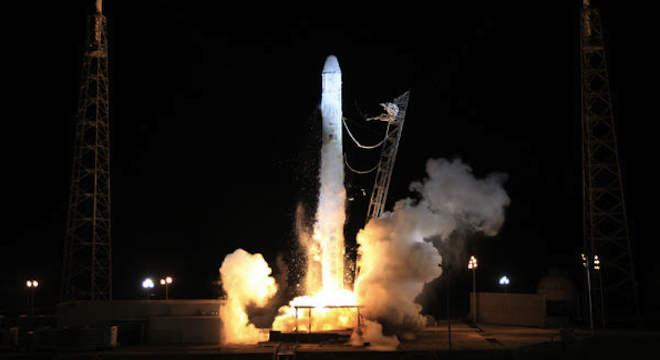Updated 11:33 a.m. EDT, Monday, October 8
SpaceX successfully launched its unmanned Dragon cargo capsule on a mission to the International Space Station at 8:35 p.m. EDT on Sunday.
The launch, which took place at the Cape Canaveral Air Force Station in Florida, is an historic one for SpaceX, the private company founded by entrepreneur Elon Musk: It’s the first ever official cargo resupply mission in outer space by a private company, and the first of 12 planned flights under a $1.6 billion contract SpaceX has with NASA.
About 20 minutes after liftoff, the SpaceX Dragon capsule reached orbit 212 miles above the Earth and detached from its Falcon 9 booster rocket, which will be left behind as the capsule heads for the International Space Station with over 1,000 pounds of cargo, including numerous science experiments and a freezer for the astronauts now aboard the station.
The Dragon capsule deployed its solar arrays, which will power the craft’s electronics going forward.
NASA and SpaceX livestreamed the launch on their respective websites, and a NASA announcer called the launch “picture perfect,” and “flawless.”
The Dragon is due to reach the International Space Station in the next few days and rendezvous with the station by Wednesday. It will remain coupled to the station for the next nearly three weeks and is due to return to Earth carrying over 2,000 pounds of return cargo in late October.
SpaceX in May made history by completing the first ever berthing, or unpowered docking, of a private spacecraft, also sending its Dragon capsule and some cargo to the International Space Station. That mission was a test for this one.
Late updates: As it turns out, though “flawless” to the observer, the SpaceX Dragon launch actually did experience a glitch which it overcame: One of the Falcon 9 booster rocket’s nine “Merlin” engines experienced “an anomaly,” which caused the computer to shut it off and burn the other engines for a longer time period to compensate. Elon Musk explained the situation in more detail in a statement to NASAWatch.
NASA also revised the total return cargo load up to 2,000 pounds from an initial estimate of 734 pounds.






